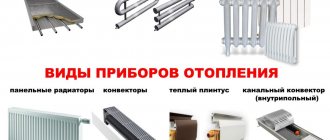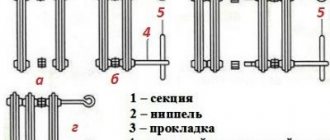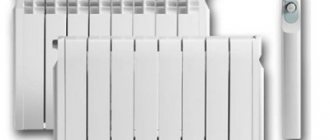Ball Valves
Valves are cheap, but at the same time ineffective control devices.
Ball valves are often installed at the entrance to the radiator, with the help of which they regulate the flow of water. But this equipment also has another functionality - shut-off valves. Valves are used to completely shut off the flow of coolant into the system. For example, in the event of a leak in a heating device, ball valves located at the inlet and outlet of the radiator allow repairs to be made without stopping the heat supply and draining the liquid.
Heating radiators in the apartment cannot be adjusted using ball valves. They have only two positions - completely closed and open. An intermediate position only brings harm.
The fact is that inside such a faucet there is a ball with a hole, which in its normal position is not in danger, but in all other situations the solid particles present in the coolant grind it down and pieces break off from it. As a result, the tap will not be sealed and in the “closed” position, water will continue to flow into the battery, which can lead to big troubles if the device leaks.
If one of the property owners decides to control the radiators using ball valves, you must remember that they should be installed correctly.
This method is usually used in apartment buildings. If the wiring is single-pipe vertical, then the hot water pipe enters the room through the ceiling and a radiator is connected to it (read: “Correct adjustment of heating radiators in an apartment - comfort in the home and saving money”). The pipeline departs from the second entrance to the device and is directed through the floor to the room below.
In this case, it is necessary to install the taps correctly, since the installation of a bypass is mandatory. The bypass pipe is needed so that when the liquid flow to the radiator is closed, the coolant continues to circulate in the general house system.
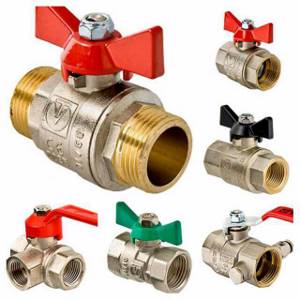
In some situations, the tap is placed on the bypass to change the amount of water passing through it and thereby adjust the heat transfer of the battery. To ensure greater reliability of the heating system, at least three valves are installed: two will be shut-off valves on the radiator and function normally, and the third will become a regulating valve.
But here we must not forget what position the devices are in. Otherwise, you can completely block the riser and you will not be able to avoid the cold in the apartment, as well as unpleasant showdowns with neighbors and representatives of the management company.
Where to contact
You must first obtain permission to replace batteries. To do this, a statement is written to the Housing Office. Additionally, you will need to provide certificates of conformity for radiators and components.
Note! If the batteries are replaced with structures that entail an increase in the heating area, representatives of the management company may require an examination to understand how the heat balance of the building will change.
A similar procedure is carried out if a major renovation is carried out in the apartment and the pipeline configuration is changed. Work must be carried out in compliance with municipal legislation. In another situation, they may be considered a violation.
Work order
To properly replace heating radiators in an apartment, you must:
- Coordinate the modification with the operation service.
- Purchase the necessary materials.
- Perform preliminary assembly of components.
- Prepare tools.
- Agree with the team (if you do not plan to do the work yourself).
- Register the alteration with the Housing Office and decide on the date for the work.
- Remove old radiators.
- Install brackets.
- Hang new batteries.
- Make connections to heating pipes.
- Check the system operation.
During the preliminary assembly of the units, all the necessary elements are installed: plugs, gaskets, Mayevsky taps, etc. In addition, you can mark in advance the places where the pipes will be cut. In this case, you should use a plumb line and level to ensure that the new radiator is level.
If the supply pipes also require replacement, it is necessary to prepare these elements: cut pieces of suitable length, attach tees, etc. All this is done in order to quickly complete the installation after draining the water from the heating system. This measure will be more than relevant if the need to replace old batteries arises during the heating season.
Welding is used to replace metal pipes. The edges of the structures will need to be threaded to securely connect them to the radiator
The procedure for removing old batteries depends on whether the pipes also need to be replaced. If the supply lines need to be preserved, you will have to carefully unscrew the old battery
At the same time, it is important to maintain the squeegee - a sufficiently long thread on the edge of the pipe. The radiator is fixed with a nut and coupling, which will have to be unscrewed
The procedure can be quite complicated. If the parts do not budge, you can try to loosen the connection using anti-corrosion compounds. In the most extreme case, the radiator is simply cut off with a grinder. There should be at least 10mm of thread left. Burrs should be removed from it.
If you decide to leave the old steel pipes, then dismantling the radiator must be carried out carefully so that the threads on the pipes remain intact
If it was not possible to maintain the flow, you will have to extend the pipes and also cut new threads. The removed locknuts can later be reused when installing a new radiator. It is much easier to dismantle the radiator if the pipes are also replaced. In this case, they are simply cut off in a suitable place. This is usually where the system turns toward its neighbors above and below.
Now you need to install the brackets and then hang the new radiator on them. At this stage, it is sometimes necessary to adjust the length of the supply pipe. All that remains is to restore the threaded connection
It is very important to perform the compaction correctly. For this, flax or plumbing thread is usually used.
Some craftsmen do not recommend using FUM tape on such connections. The seal is wound clockwise so that it forms a cone growing from the edge of the thread. Then screw on the connecting nut. If some of the seal remains outside, this is normal. But its layer should not be too thick.
Such work generates a lot of waste. They are best done during major renovations, after the windows are installed.
To achieve maximum tightness, sometimes the seal is impregnated with paint, after which the lock nut is screwed on. Then the protruding insulation is also impregnated with paint. A water-based composition is not suitable for these purposes. Once the paint has dried, it is very difficult to unscrew the connection.
Once the connection is complete, remove the protective film from the radiator. It is also necessary to check the position of the air vent. Its hole should be directed upwards. To check the quality of work, you need to ask plumbers to pump water into the heating circuit under pressure.
It is better to remove the film in which the new radiator is packaged after it is installed, so as not to accidentally damage the coating
This will allow leaks to be identified and repaired immediately. During operation, it does not hurt to observe the radiator for the first time, and also check the condition of the connections to make sure that they are not leaking.
How to change the battery in an apartment: change the batteries before the heating season begins
When undertaking a major renovation or even updating a boring interior, the apartment owner often feels the need to replace the heating radiators, since they do not fit into the chosen style of the new room design.
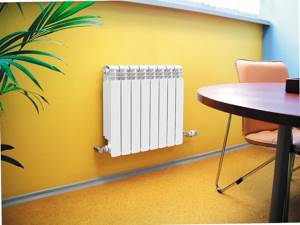
How to change the battery in an apartment
Another reason when it is necessary to replace these heating circuit elements with new ones is the low temperature in the apartment during the winter season due to cold or insufficiently warmed radiators.
Expert opinion: Afanasyev E.V.
Chief editor of the Stroyday.ru project. Engineer.
To know how to change the battery in an apartment, you need to have information about some of the nuances of this process. However, before going to the store for new radiators, if the homeowner is quite satisfied with the old ones in appearance, you can try to revive them using existing cleaning technologies. For this process, you can invite a specialist from an organization that maintains the heating system of a given house, but it is quite possible to do this yourself - tips for flushing the heating system are posted on our portal in the corresponding publication. Perhaps with the help of such an event the problem will be solved.
If you finally decide to get rid of the old-style batteries and install one of the modern radiator options, then you need to choose the most suitable one for use in a specific circuit, taking into account the characteristics of the heating system and the area of the heated room.
What do you need to know to make the right choice?
To make the right choice, you must first contact the service company and find out the parameters of the heating system of the house, such as the pressure and temperature at which the coolant is supplied to the circuit of the house and distributed among the apartments. In addition, you need to clarify with specialists what specific power a radiator should have per unit area for the specific conditions of a given building.
The correct choice will determine the temperature not only in the apartment where the radiators will be replaced, but also in others located in the neighborhood.
This is the basic necessary information that you need to know, since without it it will be difficult to choose a reliable and efficient heating radiator.
How to choose the type and model of radiator for an apartment?
Knowing the parameters of the heating system at home, you need to take a closer look at the characteristics of the radiators that you decide to install - how suitable they are for installation in a central system.
It is necessary to take into account that, due to technical characteristics, not all types of radiators can withstand the aggressive environment that is created in an open heating system due to the saturation of the coolant with oxygen, as well as possible water hammer due to pressure drops, which are characteristic of central heating from boiler houses.
The selected batteries must function effectively with a specific pressure level and chemical composition of the coolant, delivering maximum heat to the premises, fulfilling their immediate purpose.
In addition to these factors, the design of the heating elements is important, since they must fit perfectly into the interior.
Today, traditional cast iron, but modernly improved radiators, as well as newfangled aluminum, steel and bimetallic ones, remain quite popular.
- Modern cast iron radiators are radically different from old domestic models. They have an aesthetic appearance and are available in different versions, so you can choose from them samples suitable for both modern and retro interiors. But still, the main advantage of batteries made of cast iron is their resistance to aggressive internal and external environments. Imported models of cast iron radiators have absolutely smooth internal surfaces, so there are no obstacles to the active circulation of the coolant, and there are no prerequisites for the formation of layers of scale.
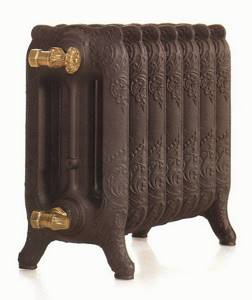
In addition to the listed positive qualities, all cast iron radiators always have a high percentage of heat transfer.
In addition, such batteries are not afraid of pressure surges in the system and high temperatures, so they are excellent for installation in multi-apartment and multi-storey buildings connected to a central heating system.
- Another ideal option for apartments are bimetallic combined radiators, made from two different alloys. The steel surface of the internal part of the radiator structure can withstand pressure reaching up to 40 bar, and the aluminum outer surface, which is decorated with enamel, provides excellent heat transfer to the room. Moreover, the surface heats up evenly, so the area releasing heat is quite large.
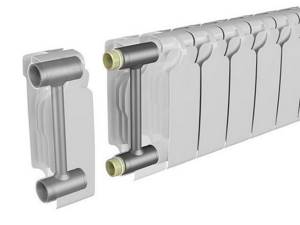
The batteries have a modern appearance and will decorate any interior, emphasizing its style.
- Radiators made of steel are divided into panel, sectional and tubular. The advantage of this type of radiator is the variety and aesthetics of the design and effective operation in an autonomous closed system with high-quality coolant. It is not recommended to install them in circuits connected to a central heating system, since an aggressive environment and temperature changes can damage the housing, especially in the most vulnerable places - along the welds. However, if such batteries have already been purchased, it is necessary to install a reducer on each of them, which will automatically equalize the pressure, thereby preventing unnecessary stress from occurring in the metal case. This easy-to-install device will help preserve radiators for a long time without damage or leakage.
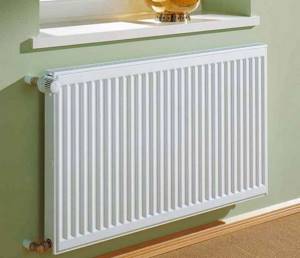
Another significant disadvantage is that some steel radiators do not have a coating that protects the internal surfaces from corrosive processes. When choosing, you should pay special attention to this.
- Aluminum radiators, like steel ones, are not particularly suitable for open heating systems, since when in contact with an aggressive environment, aluminum is prone to oxidation.
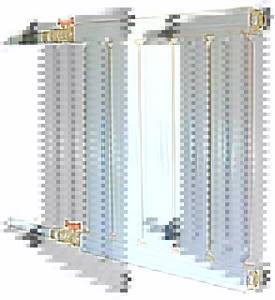
They have an excellent appearance, which at first glance is absolutely identical to the bimetallic options, but the technical characteristics are just as different from them.
Radiators made of this material are good for an autonomous closed heating system, with an even pressure of clean coolant and a stable temperature set. Unexpected changes in temperature and pressure may occur in the central system, which can negatively affect the seams of the sections. Damage to the seams is quite possible, especially if oxidation processes develop inside the sections. That is why it is not recommended to install such elements in multi-storey buildings.
More details about the performance qualities of heating radiators can be found in the article on our portal, specifically devoted to this problem.
Calculator for calculating the number of radiator sections
Expert opinion: Afanasyev E.V.
Chief editor of the Stroyday.ru project. Engineer.
It is important not only to choose the optimal radiator, but also to correctly determine the number of its sections or total thermal power. To do this, we suggest using the capabilities of the built-in calculator, which takes into account many nuances important for creating an effective heating system for a specific room:
Go to calculations
Prices for popular models of heating radiators
Heating radiators
Tools and necessary components for installing radiators
If you decide to replace the batteries yourself, then you need to prepare some tools and additional components with which you can install radiators in the heating system.
Tools you will need:
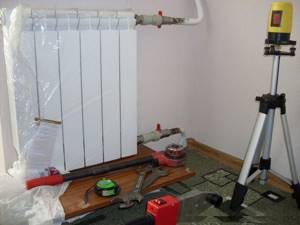
Tools for installing heating radiators
— wrenches and adjustable wrench;
— angle grinder – “grinder” for cutting metal pipes;
— for metal pipes you will need a die for cutting threads or a die with a holder of the required diameter;
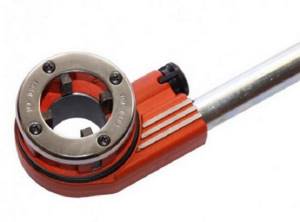
Klupp is a special tool for cutting threads on pipes of various diameters
— welding machine for polypropylene pipes;
— scissors or a hacksaw for cutting polypropylene pipes;
- level, pencil and long ruler;
- tow;
- sealant;
- cement mortar for sealing holes around the brackets.
The following components are required to be purchased:
— selected radiators;
- Ball Valves;
— brackets for hanging batteries;
- plugs - plugs;
— Mayevsky valves for bleeding air;
- new metal-plastic, steel or polypropylene pipes, necessary elements for their installation - tees, transitions, bends, fittings, etc.
Video: what is needed to install heating radiators
Prices for components for installation of heating radiators
Accessories for installation of heating radiators
Permission to replace system elements
Replacing batteries in a high-rise apartment is more difficult than in a private property, since this process during the heating season or when the system is under pressure will require disconnecting the entire riser from the central circuit, at least for some time. You can turn off the pipes at the beginning and end of the circuit installed in the apartment and install ball valves on their incoming sections.
This means that many apartments will be left without heating, so it is better to carry out measures to replace pipes or radiators at the end of the heating period or before it begins.
However, if circumstances still force installation work to be carried out during such an inconvenient period, you will need to contact the housing maintenance organization with an application to temporarily disconnect a certain riser of the house. Shutting off the coolant supply to the common house system should only be carried out by a specialist who has access to the place where the circuit is inserted into the central house manifold.
After turning off the riser, the water is drained from it, and only after this can you begin to dismantle the old batteries or all the pipes inside the apartment. If, for example, you plan to change them to polypropylene.
How to change the battery in an apartment - do it yourself
You can independently undertake the process of dismantling and installing batteries only if you have skills in welding polypropylene, “packing” plumbing threaded connections, cutting threads, if necessary in specific conditions, and working with other necessary plumbing tools.
Replacement of circuit elements occurs in several stages:
Removing old radiators
If there are no plans to replace the metal circuit with polypropylene pipes, then work begins by unscrewing the threaded connections connecting the battery to the pipe. It often happens that the thread does not give in due to the rust that has formed. In this case, a grinder is used, with the help of which the battery is cut off from the pipes suitable for it.
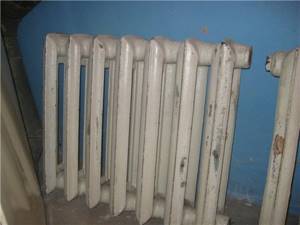
The first step after draining the coolant from the riser is to dismantle the battery to be replaced
If all the pipes in the circuit are replaced with more aesthetically pleasing and easy-to-install polypropylene pipes, then they are cut off at a distance of 15-20 cm from the wall, regardless of where the battery is located.
All work must be carried out carefully, placing an asbestos sheet or other non-flammable material under the cutting and welding area so as not to damage the floor covering.
Preparation for installation
Having freed the wall from the old battery, mark the installation location of the new one on its surface, calculate and mark the points where the brackets will be mounted into the wall. All marking parameters are determined taking into account the total size of the battery and the distance between sections. In order for the horizontal and vertical to be ideal, a building level must be used for marking. It is best to outline the future location of the battery using a pencil or marker.
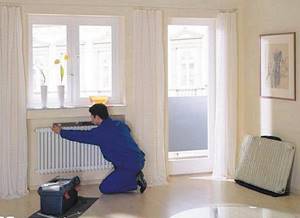
Installation must be preceded by careful measurements and markings
Holes are drilled in the places designated for the brackets. Depending on the type of brackets you purchase, they may be driven into the wall or screwed into place. If the wall was damaged during the drilling process - deep holes or holes appeared, it must be immediately cleaned and sealed with a cement composition, which must dry well before hanging it on the battery brackets.
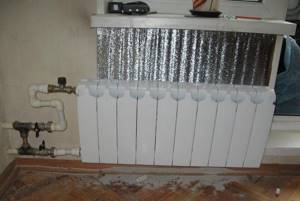
It is advisable to cover the surface of the wall behind the battery with foil thermal insulator
To prevent heat from being wasted for unnecessary heating of the wall, it is recommended to attach a piece of foil insulation to it. It should be located along the entire width and length of the battery, and also rise right under the window sill. In this way, you can increase heat transfer from the radiator - direct thermal radiation towards the room.
Installation of new radiators
After preparing the place, you can proceed to further actions.
- If you decide to leave metal pipes, then threads are cut on the remaining sections using a die. If necessary, a pipe section is lengthened by welding or threading and connecting two sections with a sleeve.
- On the supply pipe and on the return pipe, the cut threads are wrapped with tow, then the seal is coated with sealant paste and the ball valves are screwed on.
- The battery is hung on the brackets. The required straight length for connecting it to the ball valves is measured.
- Squeegees are screwed into the threaded part of the battery, with the help of which the radiators are “packed” with the supply and return pipes. To seal the joints, it is best to again use tow with a special paste coated with it.

You can carry out the installation the “old fashioned way”, using a regular drive...
- Installation will be even easier if you use modern flange couplings with a union nut - they are often called “American”. At the same time, this approach will simplify the removal of the battery if such a need arises. You can purchase a kit that includes both an American valve and a ball valve - this will make the work even easier.

... however, it is more advisable to use flange connections with a union nut - “American”
- If the radiator is installed at the highest point of the riser, then a Mayevsky tap is installed at the top on the opposite side of the tie-in. After filling the circuit with coolant, the air that accumulated while filling the radiator is released through this tap. The absence of air pockets is a necessary condition for free circulation of water in the system.
- A plug is screwed into the bottom of this side of the battery.
- If the circuit continues, then instead of the Mayevsky tap, a supply pipe is installed, a return pipe is installed below, which are then connected to the next battery.
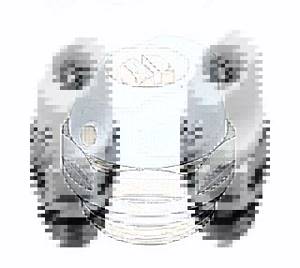
Mayevsky valve - necessary for releasing air from the system
- Metal pipes can be replaced with polypropylene or metal-plastic ones. However, threading will still be necessary - you will need to switch to a compression weld fitting. A threaded fitting or a special “American” coupling may also be required to connect the radiator itself.
At corners, places where tees are installed, or at transitions to another diameter, a specific technology is used, characteristic of a particular type of pipe. In the case of polypropylene, this is welding using a special apparatus that produces an absolutely sealed monolithic seam that can withstand both temperature and pressure loads. When replacing with metal plastic, special compression fittings are used. The entire necessary range of similar shaped and connecting elements is always available for sale.
Video: installing and connecting a heating battery
Bypass jumper installation
To install radiators in an apartment, several schemes are used - with or without a bypass jumper.
- A bypass jumper is installed in single-pipe wiring in front of the radiator for the convenience of shutting off the coolant in emergency cases, for example, if a serious leak has occurred in the battery and you need to make repairs or completely replace it. If a jumper is installed, then you do not have to shut off the entire riser, but simply close the taps behind the bypass, cut off the emergency battery from the heating system, and then you can safely remove it and carry out repairs. Thanks to the jumper, circulation in the system continues, that is, other rooms and apartments through which the riser passes continue to be heated.
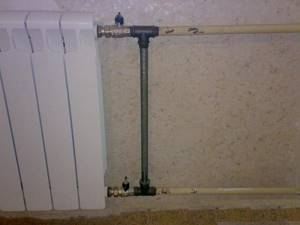
When the radiator is installed back after the repair process, the valves open and the coolant continues to circulate, but through the battery.
Another advantage of the design using a jumper is the ability to adjust the temperature in the room. Closing the taps behind the bypass reduces the amount of coolant circulating through a particular radiator. Thanks to this, the temperature in a given room can be reduced to the optimal temperature.
To insert the jumper, tees are used, which are installed on the pipes before installing the ball valves.
- If the jumper is not installed, and only a shut-off valve is assumed, then the installation process is faster and easier, but this installation scheme has one significant drawback. If the valve is closed, circulation in the entire riser stops, and not only the room where the battery is being repaired is deprived of heating, but also all others included in this circuit.

Installing a thermostat will make it easier to adjust the heating temperature and provide significant energy savings
- The bypass allows you to regulate the room temperature manually. However, greater convenience is a mechanical (sometimes electronic) thermostat, which is mounted at the inlet of the radiator and will automatically maintain the set heating value.
Video: installation of a bypass jumper
Testing the system after installation
After completion of installation work and visual inspection, testing activities must be carried out. To do this, it is necessary for specialists to release coolant under pressure into the heating system. If defects are detected in the installation and leaks on the threaded or fitting connections of the radiator and underwater pipes, you must try to quickly eliminate them, otherwise you will have to empty the riser again of water and carry out repair work.
Replacing batteries in an apartment in a multi-storey building is a particularly important undertaking, since the heating efficiency not only in the apartment of the owner changing the radiators, but also in all others located in the same riser will depend on the quality of the work performed. In addition, one should not discount the reliability of installation in the sense that complete safety is ensured against water leakage through the interfloor ceilings. Therefore, if you do not have stable skills in plumbing and construction work, then it is better not to take risks yourself, but to rely on the experience of qualified specialists.
Disabling risers
In response to my request, the Management Company said, . Show in full Hello!
Please tell me this is the situation. They turned off the control valve on the fifth floor (no need to throw slippers, it happened by accident - they turned off the battery, they forgot to open the control valve).
since it happened in winter, overnight. Show in full Good afternoon. When we contacted the management company Zhilischnik in the Rostokino district (Moscow) regarding the disconnection of the hot water and hot water risers, as well as the overcooking of the heated towel rail, we received a refusal to pay for work on the heated towel rail (“at the moment we do not provide these services.
Show in full Good afternoon!
I live in a multi-storey building, I want to replace the heated towel rail, which is made of a plastic pipe, with a metal one and, accordingly, install pipes for hot and cold water as it is convenient for me, I contacted the management company with which.
Who needs to be paid {q} Is there an official price list {q} They require payment of 1000 rubles for disconnecting the riser.
Is this legal {q} Who needs to pay {q}
Is there an official price list {q} They require payment of 1000 rubles for disconnecting the riser. Is this legal {q} Keep this in mind, otherwise there MAY be trouble.
But replacing the radiator cost about 1000 rubles, although in life they ask for three. Or they should do it for free (if there are no shut-off valves according to the house design). You just need to know your rights and laws and not mumble in the UO-ZhKS.
I was given new radiators FREE OF CHARGE.
In general, of course, the price is too high, their standard hour is 30 dollars {q}
The job consists of turning on the faucet in the attic, then in the basement, and draining hot water from the riser through the vent valve. Work 15 minutes. By the way, it’s interesting whether the prices are set by the general director of housing and communal services, and the same in other housing complexes, or the prices are uniform throughout the city and set by Housing Committee {q}
Part 2 of Article 162 of the Housing Code of the Russian Federation establishes: Clauses 1 and 2 of Part 3 of Article 162 of the Housing Code of the Russian Federation establish: “3.
Based on the presented standards, the service of turning off the water supply risers may be included in the maintenance if this is provided for in the HOA estimate, which seems unlikely for the same reasons as in the case of management of the house by the UO.
Taking into account the above, it seems necessary for the OU/HOA to fulfill: 1.
they also like to spread caviar on bread Starnet122, 3 points of 2 pipes - supply and return.
Total 2x3x300= 1800. Not everyone lives in Moscow. Not yours, but common with your neighbors. The water in the house and in the risers is common, so if you drain it or at your request, then you pay for it, but there is not much water in the risers and if it is in the estimate, it will not be very expensive.
3 points of 2 pipes - supply and return. Total 2x3x300= 1800. Not everyone lives in Moscow.
So in Moscow it’s also 500-600 rubles for a riser (I don’t know how it works with two tubes, maybe they charge for one riser). If it is not the management company, but someone from the outside who does it, disconnecting the risers can be 2-5 times more expensive and you will have to pay for each hour of disconnection. If the extortion is illegal, then everything is simple: file a complaint with the housing inspector and I will recalculate everything as it should be.
https://www.youtube.com/watch{q}v=9r9pKHHPU7s
If the extortion is legal, then the housing inspector will simply explain why it costs money and how much it costs.
What time to carry out work
Example of an application for radiator replacement
It is allowed to replace parts of the heating system during the spring-autumn period, after the water has been drained from the pipeline. At this time, repair work will not cause any trouble to others. After all the measures have been carried out, the tightness of the circuit is checked using special equipment by injecting compressed air into the riser and monitoring the maintenance of constant pressure in it. This service is paid, but damage from flooding to neighbors can be hundreds of times more expensive.
Since utility services are scheduled months in advance, applications for special services must be submitted in advance. Otherwise, you will have to replace the heating devices yourself, without permission, at your own peril and risk. It should be taken into account that in the event of an emergency, you will have to pay for repairs to your neighbors and a fine from the management company.
Preparation for work
The first thing to do before starting repairs is to turn off the riser. It is much better if the replacement is done before the radiator reaches a catastrophic state - then you can perform the replacement in the summer, without turning off the riser. A correctly chosen date, which is not part of the heating season and for which tests are not scheduled, will avoid unexpected flooding. However, a thoughtful owner will definitely prepare special dishes in advance to collect water that may have remained in the heating pipes since the heating season.
Ideally, it is better to agree in advance with the neighbors above and below so that the new pipes are connected to the old system not in your apartment, but in the neighboring ones - when connecting to the old radiators of the neighbors. Because of this, the cost of parts will increase slightly and you will have to coordinate the dates with your neighbors, but the procedure will turn out to be much simpler and more comfortable, and your apartment will definitely not be invaded with a new renovation. There is also a benefit for the neighbors, because at least part of their heating system will be updated. If you can’t reach an agreement, you’ll have to cut the metal pipes right in the middle, in your apartment, which will make the repairs somewhat incomplete.
If the neighbors cooperate, large-scale measurements of the entire scope of work need to be carried out. It is worth calculating the diameters of the outlet pipes of both neighbors and yours, and also measuring the potential length of the pipe, taking into account the interfloor ceilings. After that, you can go buy all the components. You should not think that everything will be limited to one radiator - you also need to purchase special pipes and taps for them, which allow you to turn off the heating only in your home, as well as various plugs and gaskets that ensure uninterrupted operation of the system even when your battery is removed.
Laying heating pipes
Once the old heating system is removed, it's time to think about a new one. One of the questions in the instructions on how to change the battery in an apartment is the method of laying new pipes. First of all, one of two options is selected:
- Open
- Hidden
From an aesthetic point of view, hidden gasket is much better. Communications will be hidden from human eyes. However, this method has a number of disadvantages:
- Further maintenance of the system is difficult
- The cost of the work being carried out increases, and additional costs for building materials will appear in the estimate.
- A certain percentage of the heat will go to heating the decorative structure
The advantages of open heating systems, due to which they are preferred, are obvious to everyone:
- Lower cost of installation work, since materials are consumed in minimal quantities
- The pipes are in direct contact with the environment, thereby eliminating heat loss
- Simple further maintenance of communications
- Small time costs for laying pipes
Hidden pipe laying
As noted, hidden pipe laying is labor-intensive and time-consuming work. First, prepare:
- For natural circulation of the coolant, the pipe is placed directly into the suspended ceiling, and the outlet risers are run along a protective decorative box
- For forced circulation, a good solution would be to lay pipes in the walls or floor
- Markings are applied to the working surfaces and grooves are made with a hammer drill or grinder
The pipe is secured directly in the grooves with clips. In this case, near future radiators, the line should end with removable threaded adapters.
It is necessary to start decorating the surfaces only after all the batteries are in place and crimping has been carried out.
Open pipe laying
Laying pipes using the open method is more popular. At the first stage, you need to install radiators, an expansion tank, a boiler and other heating equipment.
In order for the pipes to look aesthetically pleasing, their exact location should be calculated. Diagrams sketched on paper taking into account the location of the furniture will not be superfluous.
Open laying can be organized in one of the following ways:
- The upper discharge pipe of large internal cross-section is laid between the radiator plugs under the window sill, while the pipe running along the bottom is led along the floor
- Both pipes are routed along the floor, but this method is only suitable for forced circulation
- For natural coolant circulation, the lower pipe is placed directly near the floor, and the upper pipe is placed as high as possible
Having decided on the method of laying the pipe line, you need to mark the walls and install retaining clips. The frequency of their location is 1-2 m. It is necessary to take into account that it is recommended to make the areas between the radiators solid. In non-standard areas, two clips are placed at the junction points - on one side and on the other.
Particular attention is paid to branches and turns. Before trimming, you will have to take careful measurements, have a design and engineering vision
We also advise you to find out more about individual heating in the apartment
Installation of new batteries
Before installing heating radiators in the apartment, you need to calculate everything again and accurately measure their location. In this case, you should not violate the rules prescribed in specialized documents (SNiP):
- Approximate distance between the floor and the bottom edge is 15 cm
- The approximate distance between the window sill and the top edge is 15 cm
- The gap between the radiator and the wall is at least 2 cm
First you need to secure the brackets on which the new radiators will be hung. Then nuts are put on them. All connections must be well sealed to prevent water leakage. It is also recommended to apply tow. There will be taps at each entrance.
The final working stage will be to check the entire heating system for operability. To do this, one end should be plugged, and on the other side, create a pressure with a pump or compressor that exceeds the working one by 1-2 atmospheres. If after some time the readings of the measuring pressure gauge do not change, you can screw in all connections and connect to the central system.
Additional video
Let's sum it up
There is definitely something difficult and impossible to do in how to change the battery in an apartment. However, you can’t count on easy work either. After completing the work, it is recommended to call a technician and let him verify that the system is assembled correctly.
Is it possible to replace radiators yourself?
If the apartment owners do not have an engineering education with a specialization in heating systems, it is better to entrust the replacement of radiators to professionals. The slightest mistake can lead to the batteries not heating well or starting to leak.
For example, I know stories where, due to lack of knowledge, batteries were connected to the hot water supply system. It seems logical: in order for appliances to heat, hot water must flow into them. But no, radiators can only be connected to the pipes of the heating system, otherwise they will quickly become unusable.
The fact is that the heating system always uses the same water, which is used in a closed cycle. And if there are any harmful impurities in it, their effect on the battery metal is limited. In a hot water supply system, water flows through an open cycle and is constantly renewed, so new impurities will constantly appear, which will harm the radiators over and over again.
Some apartment owners entrust the installation of batteries to teams that do other repair work: laying floors, plastering walls, gluing wallpaper. But they often do not have an engineering education, and they know no more about heating systems than the apartment owner.
The best option is to contact specialists, at least a full-time plumber of the management company. At least if problems arise, there will be someone to file a claim with. The main thing is to get documents from the plumber or management company about the replacement, because replacement without documents is no better than the work of an incomprehensible master from the Internet.
You can also use the services of specialized organizations
When choosing a contractor, it is important to pay attention to several points
The company must have a license to install heating systems. It is useful to read reviews about a potential contractor and understand how long they have been in business. It is necessary to conclude an agreement that will indicate the terms of work, their list, cost and guarantees. Finally, it is important that, following the replacement, the technician performs a pressure test of the system (this is also done in the summer). This way it will be possible to detect possible leaks that specialists must eliminate
And only after this is it worth signing a certificate of completion, which will be useful if problems arise with the radiators in the future.
Who does the installation?
Theoretically, the management company, that is, the housing office, should finance and carry out work on replacing radiators. Since 2006, Russian Government Decree No. 491 has been in force, according to which absolutely the entire heating system of an apartment building is in common ownership, even if individual radiators are located in a privatized apartment. If the battery has become unusable by any of the methods described above, the housing office is obliged to replace it without charging the tenant or owner of the living space an additional fee, since such replacement is paid for out of the monthly rent paid.
In practice, of course, everything looks completely different. In an apartment that is state-owned, it is somewhat easier to obtain a free replacement, but in privatized housing you will have to face illegal extortion when the management company demands to buy a radiator with its own money, or even pay for the work performed. Moreover, it will be very difficult to convince housing office employees that the radiator is really worn out - they will agree with the owners’ arguments only if the radiator’s unsafe condition is not only obvious, but causes concern. This cool attitude is especially noticeable when trying to get free repairs.
Often, the management company also delays replacing the radiator for as long as possible, preferring to make do with minimal repairs to existing equipment. Even a noticeable excess of the planned operational life (maximum 40 years) is not a sufficient argument for the housing office if they consider it possible to limit themselves to cosmetic repairs. If everything is in relative order with the battery, and the main motivation of the owner is to update the appearance of the apartment, then you can forget about a free replacement - if the housing office starts doing this, it will be exclusively for your money.
In any case, the procedure is not so simple. If we are still talking about a free replacement through the housing office, it is necessary to submit to the institution two copies of the corresponding application, each of which must be marked with the number and date of the document, as well as the signature of the office employee who accepted such an application. In reality, such a document is needed in one copy, but the second is done just in case - to make it easier to assert your rights to free repairs.
In this case, it is also necessary to coordinate the replacement in accordance with the parameters of the heating system in the house. The fact is that the system of each house is designed specifically to use batteries of the size they were at the time of construction, therefore installing any other radiator (larger, with increased heat transfer, made of a different material, or simply in an unspecified place) can lead to serious failure of the entire system. If the repair is organized by the housing office, then they must resolve this issue on their own, but if the owner does everything on his own, he will need special permission, unless one radiator is replaced with another, completely similar.
Permission can be obtained only after a package of documents has been submitted to the regulatory organization, which includes, in fact, an application for replacement and a registration certificate for the living space, a document confirming ownership of the premises, as well as certificates confirming the compliance of absolutely all replaced components, including even fittings , the requirements of the existing system. In some cases, a document is also required confirming the positive conclusions of the examination on the possibility of modernizing the system. An examination of thermal calculations is required in situations where the new radiator differs significantly in technical characteristics from the old one or will be installed in a different location, as well as if they want to add new links to the old battery. This service, of course, is not free.
When permission is finally received, you still need to submit an application so that the riser is turned off and the coolant is drained from it, otherwise during the repair process you can globally flood your own apartment. But even this is not where the paperwork ends, because after all the work is completed, another examination will have to be carried out - a technical one. This time, the management company must check whether the work performed corresponds to those for which you received permission, and whether replacing the radiator has harmed the entire heating system.

When is the best time to change heating batteries? | ThermoConnect
When is the best time to change heating batteries?
So let's look at options for replacing heat supply at different times of the year
There is an opinion that it is better to replace the heating supply in the summer, when the previous heating period is over, and there is still time before the new one. And this is the first and main misconception. Despite the fact that during the non-heating period the batteries are cold, there is water there, since if it is not there, the batteries will simply become overgrown with rust. In other words, if you want to change the heating system in the summer or spring, you will still need to contact the housing office so that the workers give permission or themselves drain the water from the system so that you can carry out the heating installation process. As an exception to the rule, there are cases when the services of the utility company themselves carry out planned work to replace pumps, pipes, etc., in other words, preparation for winter.
It’s great if your plans coincide with the plans of the housing office. In another case, you will have to contact the chief engineer of the management company and find out whether there is water in the risers or whether it needs to be drained. Of course, this is very easy to do, especially since at above-zero temperatures outside the need for heat supply is not too great, as at -20°C. And this is the main advantage of replacing the heating supply in the spring and summer. However, there is also a minus - you will be able to check whether everything has been done conscientiously only at the very beginning of the heating season, when water under pressure enters the risers. And here, unpleasant surprises are possible.
Replacing batteries during the heating season, pros and cons
As in the situation with spring (summer), when replacing batteries during the heating season, before carrying out work, you need to enlist the support of the housing office in the matter of turning off the heating risers. To do this, submit an application on paper to a serious person at the management company (chief engineer) and, having paid for the issued receipt in the banking structure (on the Internet), you can begin work. Since the procedure for emptying risers of water is not free, housing and communal services employees will easily fulfill your request.
The key advantage of the autumn-winter heating installation process is a quick check of the quality of the work performed, because everyone knows that leaks may appear in the welding areas and on the threads, and it is better to remove it immediately by repeating, very high-quality welding. Also, during the heating season, there are seasonal discounts on welding work, which is considered an additional plus. There is only one minus - you will have to freeze a little, and this means you need to act quickly. Of course, it is not only the issue of interior beauty that serves as a reason for replacing batteries. If during winter the apartment is cool and uncomfortable, and the housing office cannot help resolve the issue, it means that hot water does not reach the radiators due to wear and tear on the heating system. Either replacing the batteries or using an IR heater will help.
Option 2 if you plan to replace the battery at will
If, according to plumbers, there is no urgent need to replace the battery, but you still want to replace the radiator, there are two options.
Method 1 – classic (turn off the heating)
To carry out repair work, you need to contact the organization that is responsible for the heat supply to the house and obtain permission to turn off the heating. As a rule, such permission can be obtained if the outside temperature is not lower than minus 10 - minus 15 degrees. If it is colder outside, turning off the heating may be refused. Also, permission to replace the battery will be difficult to obtain if you need to replace radiators in the entire apartment. The service for turning off heating risers is usually paid.
The shutdown time must be agreed upon with the technician who will carry out the work. It is necessary to notify all neighbors that the heating will be turned off in the house.
It is very important to choose a professional team of craftsmen so that the work is completed in the minimum time. If the work drags on, residents and their neighbors will have to stay in cold apartments
Method 2 – modern (freezing heating pipes)
Technologies do not stand still, and apartment owners are provided with new convenient opportunities. Special equipment has appeared for freezing heating pipes. The equipment creates an ice plug in the pipes, and the batteries can be changed without turning off the heating. The work is carried out much faster; you do not need to obtain permission to turn off the heating. There is a condition - freezing will work when circulation in the system completely stops. Let's take a closer look at how this works.
To replace the battery, it is necessary to “stop” the water in the pipes. To do this, in the classic version, which we discussed above, water is drained from the riser, and after the work is completed, the system is filled again. When using a pipe freezer, these two steps are not required. Certain sections of pipes freeze, temporarily stopping the water. An ice plug prevents water from moving through pipes and lines.
There are several types of devices for freezing pipes. Most of them run on liquid carbon dioxide. Such devices have certain features:
- The need to have spare cylinders, which will be needed to maintain the formed ice plug during work.
- Constant monitoring of the presence of gas in cylinders is mandatory.
- High-quality ventilation is required during work due to the risk of carbon dioxide accumulation.
There are also other types of devices for which you do not need to buy refrigerant and bring cylinders. These include, for example, Rothenberger ROFROST TURBO 62206. Such devices provide fast and reliable freezing without the need to transport gas cylinders. The freezing performance of the devices is high - the apartment will not have time to “freeze out”.
Devices for freezing pipes have a wide range of applications, but it is better to clarify the technical feasibility of their use specifically at your facility with specialists. Whatever battery replacement method you choose, now you know that replacing the battery in winter is quite possible.
Those who have encountered replacing batteries in an apartment know that summer is the most suitable period for this. Despite the fact that water is in the pipes in the summer (to avoid rusting the inner surface of the pipes), this procedure is much more difficult to carry out in winter. This is due to the fact that in summer people do not physically feel that the water has left the risers, and in winter the water is drained is fraught with a sharp drop in temperature in apartments, and this can cause great inconvenience to you and your neighbors.
However, many people are forced to resort to replacing batteries in winter. ZhEK and DEP very willingly agree to replacement during this period. Some even believe that carrying out work during this period gives more advantages than disadvantages, because to check the quality you do not need to wait several months before the start of the heating season. You can check the quality of installation and welding work on the same day after resuming the water supply to the risers. In addition, in winter, due to low popularity, battery replacement services are somewhat lower.
One of the disadvantages is that the replacement procedure during the heating season should be carried out in the shortest period of time so that heat losses in your and neighboring apartments are minimal.
As we can see, replacing batteries during the heating season is quite possible and even has some advantages compared to the summer period.
Replacing heating batteries in an apartment through the management housing office
At the time of an accident (for example, a radiator has leaked), replacing the heating battery lies entirely within the responsibility of the organization, to whose account residents transfer money for maintaining common property and carrying out major repairs. It cannot be said that such a replacement occurs free of charge. Cases of coercion to purchase new devices are not uncommon. It happens that receipts are issued for the cost of work performed.
The most unpleasant thing is if the battery replacement process is needed in emergency mode during the heating season. And representatives of the management company will begin to evade their obligations, citing the fact that they have neither time, nor workers, or even the radiators themselves. They will remove the old one, install plugs and politely ask you to wait.
It turns out that residents cannot change the batteries in their apartments if they wish, because...
For example, when the replacement has already been made and you plan to legalize it, you should contact an expert commission, which, in turn, if there are no violations of the design parameters, can confirm the legality of the installation of radiators.

An examination of the compliance of heating units with the primary design and the admissibility of their installation in an apartment without damage to the overall system of the entire house is paid for by the owner of the apartment in which he wants to replace the batteries, because
For example, if the batteries purchased by the owner do not correspond to common house heating devices, then the HOA may prohibit their installation. The apartment resident must carry out such work through the housing office and coordinate with his service organization the replacement of batteries.
https://www.youtube.com/watch{q}v=fPWupSzksOw
If it establishes similar ones to those that were provided for during the design and construction of the house, it is enough just to notify the management company without waiting for a special permit. Coordination of work with the HOA When replacing radiators with heating devices of a different type (different from those envisaged by the architects), increasing its area or choosing a new installation location, an experienced specialist is required who will help calculate the possibility of installing heating devices, since the load on all thermal home network.
Activities of the housing office when changing radiators
When residents decide that their heating system is outdated, they ask a fair question: who should change the heating radiators in the apartment.
In this matter, you need to rely on the following facts:
- The change was caused by a failure (depressurization or other reason) of the system, which means that all work must be carried out by utility workers
. - Old radiators heat, albeit poorly, but if there is a desire to decorate the apartment with more modern analogues, then this “whim” will fall on the shoulders of the user himself.
In any case, the heating batteries in the apartment are replaced through the housing office, even if all expenses are borne by the residents. Without permits, any work is considered illegal. Sometimes consumers ignore such a requirement, wanting to draw up documentation after the fact of the work performed. This can only happen if the housing office workers consider the new heating system safe for the entire structure.
If residents have a question about whether it is worth changing the heating batteries in the apartment, then the answer is a definite “yes” if they have become unusable or are simply old. The replacement procedure is not that complicated, even taking into account the paperwork. Choosing a team suitable for this work will also not be difficult, but knowing that for the next 25-30 years the apartment will be heated by beautiful and modern radiators is worth it.
Batteries are replaced in winter in emergency cases when they do not warm the room. This issue is agreed upon with the organization servicing the house. The work is carried out by a specialized organization. The reasons why you need to replace your batteries in winter can vary. It is possible that an accident occurs and the replacement date cannot be postponed until the end of the heating season, then this work must be done immediately. Replacing a heating device, installing a screen or other dismantling and installation work can be carried out without hindrance in these cases. For example, heating devices that have operated for more than twenty years cannot fully perform their functions of heating rooms, and therefore must be replaced.
Some requirements during the work
The fact that the heating system is in working order during the winter period will allow you to immediately evaluate the quality and efficiency of the work performed. Replacement must be carried out one by one, when not all radiators in the apartment are turned off, but only one of them. After it has been put into operation, it is the turn of the next one. The installation of one battery can be completed within one hour, but for this (preliminary) measurements must be taken and all tools and components must be prepared.
In order to avoid loss of heat and your own health, and not to pay extra money for heating your home, the batteries must be installed correctly. In addition, you must remember that the radiator is mounted in a horizontal manner, and it must be parallel to the wall. It is installed on three brackets, one of which is located at the bottom and two at the top; the main load will fall on them. In the case of a large number of battery sections (more than 12), another bracket is (additionally) fixed in the upper part of the wall. It is necessary to maintain a distance between the top of the radiator and the bottom of the window sill, it must be at least 10 cm, otherwise the thermal curtain in front of the window will be weak.
The representative of the service organization (after completion of all work) is obliged to turn on the risers of the heating system. You must check the tightness of the joints so that there are no leaks at the joints of pipelines, shut-off and control valves.
www.kakprosto.ru
Battery replacement procedure
If your old batteries have valves, then you can replace the battery without resorting to draining the water from the risers; you just need to turn off the taps, cut off the old battery (with the assistance of a mechanic or yourself) and attach a new one, then open the valves and check the tightness of the connections.
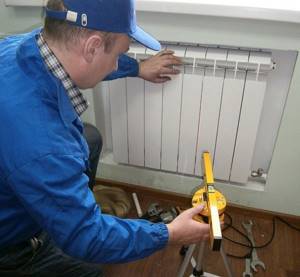
If there are no valves on old batteries, the replacement procedure consists of the following steps:
- contacting the housing office or departmental office, where the necessary documents are prepared and a receipt is issued;
- payment of the receipt at any bank branch or via the Internet.
The cost of disconnecting and draining one riser, depending on the region, can vary from 300 to 3000 rubles per hour of disconnection.
3. on the appointed day and time, several employees of the housing office/daily office carry out joint replacement work: the riser is turned off and drained, the battery is replaced and then pressure is applied to the heating system and the quality of work is checked.
In general, replacing a battery in winter is only slightly different from replacing it during the non-heating season and takes a little longer. Usually the procedure lasts 1-2 hours, so in order to avoid unpleasant situations, you must notify your neighbors in advance about your plans.
Cast iron battery
In many apartments of old houses, it is the cast-iron battery that needs to be removed, so the first thing you have to do is contact the housing office or the building manager. This must be done because you will have to drain the water from the heating system, and this can only be done by an appropriate specialist.
After you have agreed to lower the system on a certain day, you need to prepare the tool. You will need:
- pipe wrench number 3, in order to unscrew the locknuts and fittings (special nuts that connect a pipe of a larger diameter to a pipe of a smaller one);
- pipe cutter or grinder for cutting pipes;
- hacksaw for metal;
- hammer;
- chisel;
- metal brush to remove rust;
- blowtorch or industrial hair dryer;
- basin for water;
- rags.
After all the tools are prepared and the water has been drained from the system, we proceed to dismantling.
- It should be remembered that if there is no water in the system, this does not mean that the battery is completely dry. This is why we need a basin and rags. They should be used to remove remaining water from the radiator after dismantling.
- As a rule, old radiators are covered with more than one layer of oil paint. And not only the radiators themselves, but also all the fasteners. To remove the paint, use a blowtorch or hair dryer. We need to burn off the old paint on all joints.
- After this, we finally clean the connections with a wire brush.
- Now, using a pipe wrench, unscrew all the nuts. It is this period of operation that is the dirtiest, since the remaining rusty water will pour out of the radiator. You should be prepared for this.
- It may turn out that even after burning the old paint, it will not be possible to unscrew the nuts on the supply pipes. Especially if the radiator has not been cleaned for 10 years or more. In this case, you will have to use a pipe cutter or grinder and cut the supply pipes immediately in front of the radiator.
- The cast iron battery is held on the wall by special brackets. You need to lift it up and remove it. If the battery consists of 3-5 sections, you can carry out a similar procedure yourself. If there are more sections, you will need help: cast iron radiators are very heavy.
Reasons for need
Because many Soviet high-rise buildings were not originally designed to last very long, engineers did not usually consider simply shutting off the water supply to the pipes to replace the battery. Because of this, even during a major overhaul, batteries are not always changed - often they are changed precisely out of necessity, and not on a whim.
There are several reasons why it is simply necessary to replace the batteries in your apartment:
- Nothing lasts forever, and even more so metal pipes, which are in close contact with hot water for several months every year. As already mentioned, some of them have been in use for decades, so in some cases their wear and tear is not at all surprising. During operation or when heating is started in the fall, such a battery may leak, after which its further use becomes impossible.
- Over time, the heating efficiency of the radiator decreases. This is due to the fact that deposits accumulate inside the pipe over the years, which thicken the walls of the battery, which is why the heat simply does not reach the room. Moreover, during repairs, owners often also paint old radiators, which only aggravates the situation. Since it is impossible to clean the pipe from the inside, you have to replace it entirely.
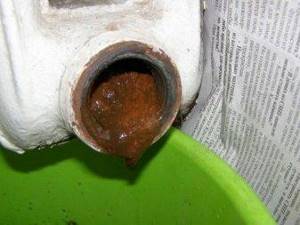
- Often, owners are simply dissatisfied with the size of the battery installed in a large room. In their opinion, more sections could be used for a room of the appropriate size, which in many cases turns out to be true. Again, there is only one solution: remove the old battery and install a new, longer one.
- After all, an old radiator can simply spoil the design of the room. Agree, in modern renovation, where plastic and other modern materials predominate, old cast-iron pipes, often peeling, look like a completely foreign body. It’s different from modern analogues, which in themselves can become an excellent decoration for the interior.
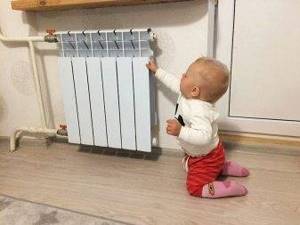
Why change batteries?
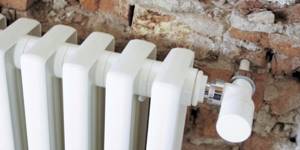
There are five reasons why you should do this.
- The batteries are leaking.
There is nothing to think about here: if even a few drops of water appear on the radiators, they need to be changed. Because sooner or later the drops will turn into a stream that will flow to the neighbors. And then, instead of spending several thousand rubles on buying a battery, you will have to shell out tens of thousands to repair your own and neighboring apartments. - It's cold inside.
If you wear wool socks every October and don't take them off until May, it makes sense to replace your radiators. Maybe the radiators currently in the apartment do not warm the rooms enough. This means that it is worth replacing them with devices with higher heat transfer. Perhaps the radiators are designed to warm the rooms to the standard 19–21 °C, and the residents are too thermophilic. Then it’s worth buying larger batteries to better warm the apartment. - The radiators look shabby.
This is familiar to everyone who had classic cast-iron radiators in their apartment, whose paint sooner or later began to peel off. But relatively new radiators can also lose their presentable appearance, for example, if the manufacturer saved money and painted them with only one layer. Or after repairs, chips and remnants of building materials appeared on them. All this reduces the reliability of the devices: where the paint has chipped, rust appears faster and a leak forms over time. - It is planned to modernize the heating system . If 10 years ago adjusting the temperature in a room using a window was considered normal, today there are more technologically advanced methods. For example, automatic thermostats or remote control of heating in an apartment via a smartphone are rapidly gaining popularity. Cast iron radiators and convectors, which once seemed like the crowning achievement of engineers, hardly fit into such systems, so they are replaced with more modern heating devices.
- The interior is being updated . Including after buying an apartment. This is probably the most common reason for replacing radiators. Sometimes old appliances simply don't visually match the new design of the rooms. And some apartment owners believe that if they are going to do any renovations, they should change everything down to the batteries.
Wrong choice of radiators
A common mistake is a mismatch between the type of radiators and the pressure of the heating system.
Radiators come in several types:
- cast iron - until recently they were the most common for standard apartments, they are distinguished by a large volume of water circulation and, accordingly, good heating; the disadvantages of such radiators include their high cost;
- metal - usually used in one-story private construction; they simply cannot withstand the coolant pressure in multi-story buildings, but the radiators are made of ferrous metal, so they are relatively inexpensive;
- aluminum - also inexpensive, easy to install, have high heat transfer, but also cannot withstand high pressure;
- bimetallic - a two-layer “sandwich” made of aluminum and metal; this option is quite suitable for high-rise buildings, but is very expensive.
So on private houses you can get by with metal or aluminum structures, but it is better not to use them in high-rise buildings.
Connection options for heating radiators
Heating battery installation diagram.
When you have to change radiators, the question inevitably arises about how to connect them. There are 2 options for installing heating batteries: series or parallel. The choice depends on the type of radiator. The best heat transfer for aluminum and bimetallic devices is achieved with a parallel connection. The sequential option is better suited for cast iron and steel radiators. However, if you live in an apartment building where, for example, there is a serial system, then you can connect radiators in parallel in your apartment only after approval and consultation with representatives of the housing office. A private house is a different matter. Here you can connect radiators in any way:
Diagram of a horizontal sequential heating system.
- serial connection. This method involves the direct inclusion of heating devices into the overall system. After installation is completed, the coolant is driven under pressure. Serial connection, incl. and repairs are carried out only in the summer, because... it is necessary to turn off the heating on the riser to which the batteries will be connected;
- parallel connection. The point is to connect to the general heating system through a separate embedded heat pipe. This option allows you to repair your heating system without shutting down the overall system. It is enough to install ball valves at the inlet and outlet. The downside is poor heating of the radiators due to insufficient pressure in the line. This is due to the fact that the coolant will flow where there is less resistance, i.e. along the main pipeline, and not along a separate branch.


